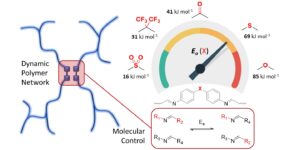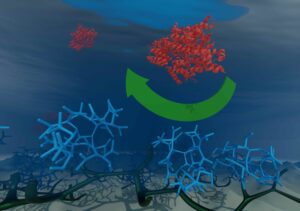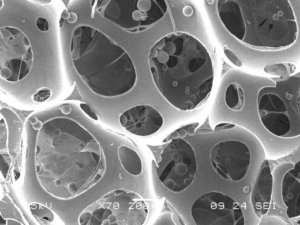In October 2013 I started my own group within the Laboratory of Organic Chemistry (at Wageningen University and Research), developing my research program at the interface of organic synthesis, supramolecular/dynamic-covalent chemistry and polymer science. Currently, my group’s research focusses on:
- Covalent adaptable networks
- Functional polymer coatings
- Sound-absorbing foams
Covalent adaptable networks
The major theme of this research line, which is funded by a NWO Vidi grant, is to employ dynamic-covalent bonds for the creation of robust, yet dynamic polymer materials. These bonds combine the robustness of a conventional covalent bond with the reversibility of non-covalent bonds. When integrated into polymer materials, this creates covalent adaptable networks that are mechanically strong, yet also remain easily processable, recyclable or self-healable. Initially, we have focussed on dynamic-covalent imine bonds, but currently we are also exploring other chemistries (see, for example, our recent work on boronate-TetraAzaADamantanes: ACS Appl. Polym. Mater. 2024).

If you’re interested to read more on this topic, please refer to our papers: for example Chem. Sci. 2021, Macromolecules 2022 or J. Pol. Sci. A Polym. Chem. 2016 (review).
Functional polymer coatings
The use of many surfaces (for example as used in (bio)sensors, printing heads, biomedical devices or marine applications) is often highly dependent on the possibility to tune and control the exact surface properties (e.g., antifouling, self-healing and/or stimulus-responsive properties). In this research line, controlled polymerisation methods are applied to grow polymer chains –also referred to as brushes– from the surface in order to impart the surface with the properties of interest.

Interested to read more on this type of research, check out the following papers: for example Adv. Mater. Interfaces 2023, ACS Appl. Mater. Interfaces 2022, Eur. Pol. J. 2021, Langmuir 2020, Langmuir 2019.
Sound-absorbing foams
This research line is aimed at developing polymer foam-based (meta)materials that can be used as efficient sound-adsorbing materials. To this end, foam-like polymer materials containing beads are prepared, characterised and applied as sound-adsorbing materials. Based on the principle of local resonances and viscous dampening, such ‘metafoams’ are capable of dampening both high and low frequency sound. As a result, metafoams can help to tackle the issue of noise pollution, which has increased in severity over the years as a result of population growth, advances in technology and urbanisation.
